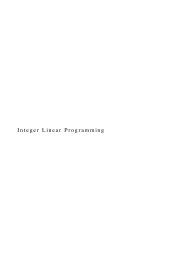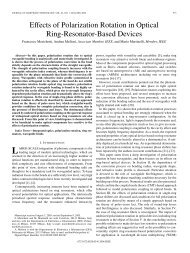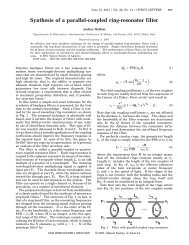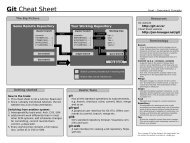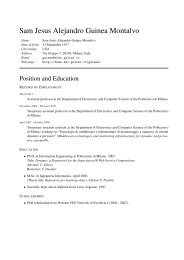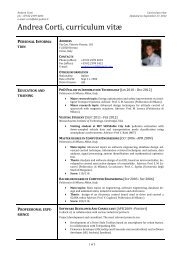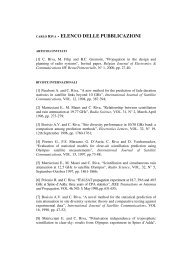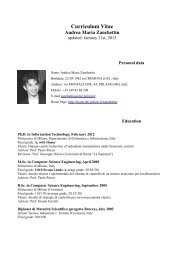Il problema della validit delle argomentazioni - Dipartimento di ...
Il problema della validit delle argomentazioni - Dipartimento di ...
Il problema della validit delle argomentazioni - Dipartimento di ...
Create successful ePaper yourself
Turn your PDF publications into a flip-book with our unique Google optimized e-Paper software.
<strong>Dipartimento</strong> <strong>di</strong> elettronica e informazione<br />
Politecnico <strong>di</strong> Milano<br />
Artificial Intelligence 2011‐12<br />
1. Introduction<br />
1.1 Course presentation<br />
The School of Information Engineering of Politecnico <strong>di</strong> Milano offers two courses on<br />
Artificial Intelligence (AI):<br />
– Artificial Intelligence, in English, given by Marco Colombetti, Mario Ver<strong>di</strong>cchio, and<br />
Viola Schiaffonati (this course)<br />
– Intelligenza artificiale, in Italian, given by Francesco Amigoni, Nicola Gatti, and Viola<br />
Schiaffonati.<br />
Topics<br />
Both courses concern what can be called core AI, that is, the main topics of classical AI, as<br />
developed since the late 1950s. More precisely, the course is concerned with seven topics:<br />
1. Brief introduction to AI: aims, research areas, applications<br />
2. The concept of a rational agent<br />
3. State space search<br />
4. Constraint satisfaction problems<br />
5. Knowledge representation in First Order Logic<br />
6. Planning<br />
7. History and philosophical issues of AI.<br />
A tentative timetable of all lessons can be found on the course’s website,<br />
http://home.dei.polimi.it/colombet/AI/.<br />
Textbook<br />
The rea<strong>di</strong>ng material is mainly constituted by lecture notes that can be downloaded from the<br />
course’s website, http://home.dei.polimi.it/colombet/AI/. This material should not be<br />
used by the students enrolled in Intelligenza artificiale (in Italian), as the two courses are<br />
similar but far from identical.<br />
As complementary rea<strong>di</strong>ng we suggest:<br />
– S. Russell, P. Norvig, 2010. Artificial Intelligence: A modern approach, 3rd e<strong>di</strong>tion,<br />
Prentice‐Hall/Pearson (1,132 pages, of which about 300 covered by this course).<br />
©Marco Colombetti, 2011. Lecture notes for the Artificial Intelligence course. This document can be downloaded<br />
from the course’s website, http://home.dei.polimi.it/colombet/AI/, and is licensed under a Creative<br />
Commons Attribution‐NonCommercial‐NoDerivs 3.0 Unported (CC BY‐NC‐ND 3.0) license, whose specification is<br />
available at http://creativecommons.org/licenses/. Comments or criticisms can be sent to the author at<br />
marco.colombetti@polimi.it.
©Marco Colombetti Artificial Intelligence 1 2<br />
The textbook is not strictly necessary in view of the final test; however, students interested in<br />
the subject are strongly encouraged to get it, as it gives a much wider perspective on AI than<br />
one can get from this course alone.<br />
Final test<br />
The final examination consists in a written test, with conceptual questions and exercises.<br />
Some of the past tests can be downloaded from the course’s website.<br />
AI‐related courses at Politecnico <strong>di</strong> Milano (Leonardo Campus)<br />
A number of AI related courses are given at Politecnico <strong>di</strong> Milano. Here is a list of the<br />
courses offered in English at the Leonardo Campus (further courses are offered at the Como<br />
Campus):<br />
– Soft computing (neural networks, fuzzy models, genetic algorithms)<br />
– Autonomous agents and multiagent systems<br />
– Knowledge engineering (semantic modelling and reasoning for the Semantic Web)<br />
– Robotics<br />
– Cognitive robotics<br />
– Data mining and text mining<br />
– Image analysis<br />
– Philosophical issues of computer science<br />
– Videogame design and programming.<br />
1.2 What is AI?<br />
The birth of Artificial Intelligence<br />
Officially, Artificial Intelligence (AI) was born in 1956, during a summer seminar at<br />
Darthmouth College (Hanover, New Hampshire), attended by John McCarthy, Marvin<br />
Minsky, Allen Newell, Nathaniel Rochester, Claude Shannon, Herbert Simon (later Nobel<br />
Prize for Economics), and others.<br />
Broadly speaking, the goals of AI are:<br />
– to design and implement computer‐based systems that exhibit intelligent behaviour<br />
– to understand human intelligence as a computational processes.<br />
What is an intelligent system?<br />
What is intelligence? This is a very <strong>di</strong>fficult question. We can try to analyse what we mean<br />
when we say that some entity is “intelligent.” That is, we can try to analyse the pre<strong>di</strong>cate<br />
Intelligent(x). To analyse a pre<strong>di</strong>cate P(x), we try to understand its applicability con<strong>di</strong>tions<br />
and its truth con<strong>di</strong>tions:<br />
– applicability con<strong>di</strong>tions: for what values of x is pre<strong>di</strong>cate P meaningful?<br />
– truth con<strong>di</strong>tions: for what values of x is pre<strong>di</strong>cate P true?<br />
As far as the applicability con<strong>di</strong>tions of Intelligent(x) are concerned, x has to be an agent, that<br />
is, a system capable of autonomous action. In everyday speech, the term “intelligent” is<br />
applied to agents, and by extension to their actions and possibly to the results or products of<br />
their actions; examples:
©Marco Colombetti Artificial Intelligence 1 3<br />
– intelligent agents: John is intelligent, my dog is very intelligent, my car has intelligent<br />
suspensions<br />
– intelligent actions: it was intelligent of John not to run away after breaking the glass<br />
– intelligent product: this is a very intelligent chair (in the sense that it has been<br />
intelligently designed).<br />
Being intelligent is not a simple concept (contrary, for example, to being a metal, or being a<br />
gas). As a consequence, we should not hope that there can be a simple theory of intelligence.<br />
Maybe “intelligent” cannot even be turned into a rigorous scientific term.<br />
Among the typical features of intelligent organisms are:<br />
– perception of the environment<br />
– problem solving and rational action (mostly human, but also present to some degree in<br />
many non‐human animals)<br />
– learning<br />
– social interaction and communication<br />
– language use (humans only).<br />
What is an artificial intelligent system?<br />
We obviously assume that an artificial intelligent system will be a system controlled by a<br />
suitably programmed <strong>di</strong>gital computer. Why?<br />
The answer is that since the 1950s there has been a wide‐spread school of thought regar<strong>di</strong>ng<br />
human intelligence as a computational process. Accor<strong>di</strong>ng to this scientific tra<strong>di</strong>tion (often<br />
called “computational cognitivism” or even simply “cognitivism”), to be intelligent means to<br />
be a physical system implementing a suitable Turing machine; this implies that, at least in<br />
principle, it is possible to completely reproduce human intelligence in a computer. Such a<br />
ra<strong>di</strong>cal view is not so popular any more among psychologists and philosophers; however,<br />
many researchers in the field of AI would probably still endorse it.<br />
Main research areas<br />
– “core” AI: problem solving, knowledge representation, reasoning<br />
– natural language processing<br />
– machine learning<br />
– computer vision<br />
– robotics.<br />
Main application areas<br />
– expert systems<br />
– planning and scheduling<br />
– optimisation<br />
– language technologies<br />
– semantic web<br />
– multiagent systems<br />
– data mining<br />
– industrial robotics<br />
– ...




